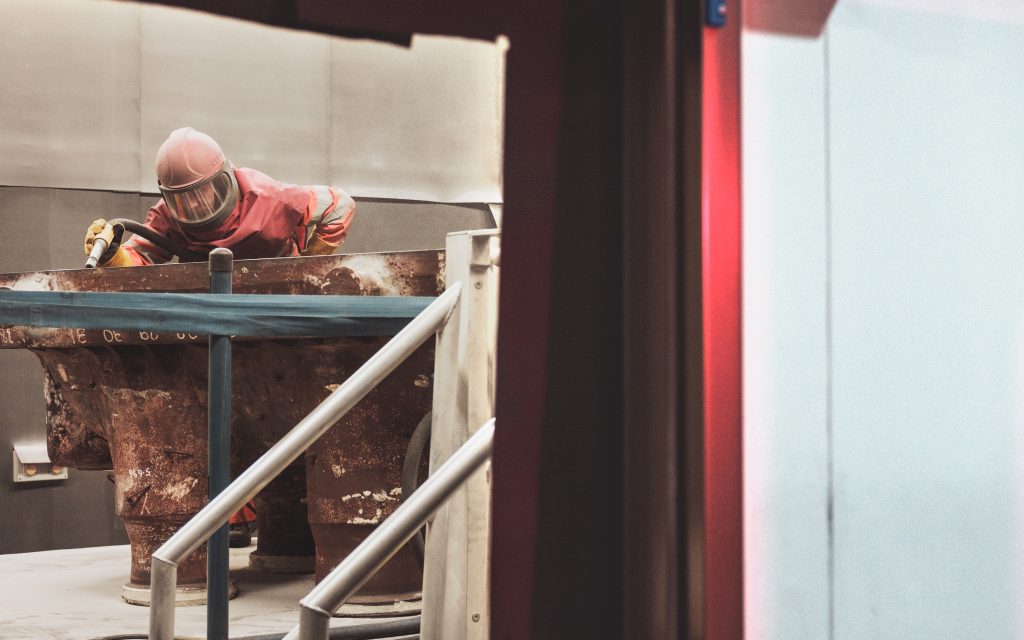When you want to clean a plate, you squirt on some soap and scrub it until the dirt’s gone. When you want to clean a steam turbine, you turn off a generating unit, disconnect the turbine, take it to a special chamber and hose it down with a combination of compressed air and tiny particles. Got it?
Welcome to the world of the blast room.
What is the blast room?
The blast room is a self-contained facility at Drax Power Station where equipment is brought during outages to be cleaned. And to be cleaned, this equipment needs to be sprayed with a mixture of compressed air and an abrasive – such as aluminium oxide, or what is known as glass bead (grit or sand).
Key features include a hose that fires the mixture of “grit” and air, and an air extraction system which filters dust from the blast room at a rate of 14,000 cubic feet per minute (CFM). To put that in perspective, a typical bathroom fan extracts air at around 70 CFM – 200 times slower. To make extra sure that workers are safe when using the blast room, they wear personal protective equipment (PPE), which comes fitted with a filtration system that provides breathable air.
But why does anything need to be blasted in the first place? To answer that, you need to consider the type of machinery in a power plant and the work it does to power your home.
What happens inside the blast room?
Consider the steam turbines – arguably the heart of any power plant – they’re consistently operating under extreme conditions.
“Each of the six turbine shaft lines weighs 300 tonnes and spins at 3,000 rpm. The high pressure turbine operates in steam conditions of 165 bar and temperatures of 565 degrees centigrade,” explains Andrew Storr, Turbine Engineer and head of the workshop, in which the blast room is located.
The steam turbines use the movement of the steam produced by the boilers on site (powered by biomass or coal) to turn the blades of the turbines, which then turn electricity-producing generators. The productivity – and profitability – of the whole plant hinges on maximising the efficiency of these units, and the team goes to great lengths to improve this, even if it amounts to seemingly tiny percentage increases.
“If we can squeeze another half a percent of efficiency out of any of our units, those gains could add up to millions of pounds of savings,” says Luke Varley, Lead Engineer in the Drax Turbine Team. That’s where the blast room comes in. “Blasting enables integrity inspections to be conducted, but also, in conjunction with our blasting team, we developed a polishing process that returns the turbine steam path surface back to a like-new condition,” he says.
The ultimate aim is to make each turbine’s internal surface as clean and smooth as possible. This way, as steam passes over the surface, losses due to friction between steam and plant are reduced as much as possible. Varley explains: “If you imagine taking a rough surface and running fluid over it, the fluid would flow far quicker and therefore more efficiently if the surface was smooth. These micro losses within the steam turbine are what we are chasing”.
Sometimes, in addition to improving operating efficiency, the blast room is used for removing residue from components in order to discover whether maintenance is required.
“At high operating temperatures, the alloy steel that everything’s made of creates an oxidised blue blush which we have to blast away with our grit blaster,” says Storr. “It’s like ‘rust’ for want of a better word. We’ve got to get that off so that we can properly look at the part and determine whether it needs repairing.”
Keeping these components clean is important. Drax provides around 7% of Great Britain’s power and for the whole process to work efficiently each part needs to be looked after. Sometimes that means locking it in a room and blasting it with a whole lot of grit.











